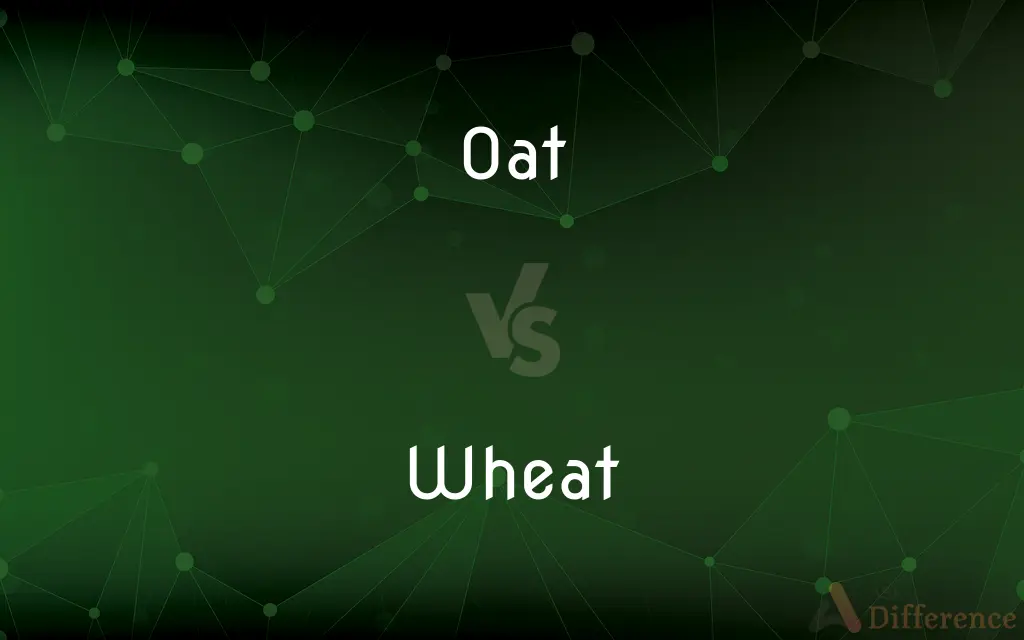Oat vs. Wheat — What's the Difference?
By Tayyaba Rehman — Updated on September 19, 2023
Oat is a cereal grain known for its rolled or steel-cut form, commonly used in porridge and granola. Wheat is a major cereal grain primarily used for bread, pasta, and flour products.

Difference Between Oat and Wheat
Table of Contents
ADVERTISEMENT
Key Differences
When examining the grains Oat and Wheat, one can observe notable differences in their appearance, uses, and nutritional profiles.
Oat, scientifically known as Avena sativa, is often recognized by its flat, elongated grains. Its popular forms include rolled oats or steel-cut oats, which are prominent ingredients in breakfast foods like porridge, oatmeal cookies, and granola bars. The versatility of Oat extends to its ability to be used as a dairy substitute in the form of oat milk.
In contrast, Wheat, belonging to the genus Triticum, has shorter, rounded grains. This cereal crop is a staple in many diets globally. Its grains are ground into flour, which becomes the primary ingredient for numerous food items like bread, pasta, pastries, and more. The presence of gluten in Wheat is also a distinctive characteristic.
From a nutritional standpoint, both Oat and Wheat offer essential nutrients. However, Oat is often praised for its high fiber content, particularly beta-glucans, which can aid in lowering cholesterol. Conversely, Wheat, especially in its whole grain form, provides a balanced combination of carbohydrates, proteins, vitamins, and minerals.
While both Oat and Wheat have played vital roles in human nutrition for centuries, they cater to different culinary and dietary needs, highlighting their unique attributes in the world of grains.
ADVERTISEMENT
Comparison Chart
Type
Cereal grain
Cereal grain
Scientific Name
Avena sativa
Genus Triticum
Common Use
Porridge, oatmeal cookies, oat milk
Bread, pasta, pastries
Grain Shape
Flat, elongated
Shorter, rounded
Nutritional Note
High in fiber, especially beta-glucans
Contains gluten, used for flour production
Compare with Definitions
Oat
Grains used for food and fodder.
She added a handful of Oat to her morning smoothie.
Wheat
A cereal plant producing grains used in baking.
The golden Wheat fields shimmered under the sun.
Oat
A cereal plant cultivated for its edible grains.
The Oat fields stretched as far as the eye could see.
Wheat
A staple food in many cultures worldwide.
Wheat bread is a common breakfast item in many households.
Oat
Often processed as rolled or steel-cut.
Rolled Oat cooks faster than steel-cut Oat.
Wheat
Contains gluten, affecting those with certain allergies.
People with celiac disease avoid consuming Wheat.
Oat
A source of fiber and nutrients.
Doctors recommend including Oat in your diet for heart health.
Wheat
Grains ground into flour for bread and pasta.
She bought a bag of organic Wheat flour from the store.
Oat
The oat (Avena sativa), sometimes called the common oat, is a species of cereal grain grown for its seed, which is known by the same name (usually in the plural, unlike other cereals and pseudocereals). While oats are suitable for human consumption as oatmeal and rolled oats, one of the most common uses is as livestock feed.
Wheat
Available in various strains, like durum or hard red.
Durum Wheat is the primary wheat used in making pasta.
Oat
An Old World cereal plant with a loose, branched cluster of florets, cultivated in cool climates and widely used for animal feed.
Wheat
Wheat is a grass widely cultivated for its seed, a cereal grain which is a worldwide staple food. The many species of wheat together make up the genus Triticum; the most widely grown is common wheat (T. aestivum).
Oat
An oat stem used as a musical pipe by shepherds, especially in pastoral or bucolic poetry.
Wheat
A cereal which is the most important kind grown in temperate countries, the grain of which is ground to make flour for bread, pasta, pastry, etc.
Oat
Any of various grasses of the genus Avena, especially A. sativa, widely cultivated for their edible grains.
Wheat
Any of various annual cereal grasses of the genus Triticum of the Mediterranean region and southwest Asia, especially T. aestivum, widely cultivated in temperate regions in many varieties for its commercially important edible grain.
Oat
The grain of any of these plants, used as food and fodder.
Wheat
The grain of any of these grasses, ground to produce flour used in breads, pasta, and other foods.
Oat
A musical pipe made of an oat straw.
Wheat
(countable) Any of several cereal grains, of the genus Triticum, that yields flour as used in bakery.
Oat
(uncountable) Widely cultivated cereal grass, typically Avena sativa.
The oat stalks made good straw.
The main forms of oat are meal and bran.
World trade in oat is increasing.
Wheat
(uncountable) A light brown colour, like that of wheat.
Oat
(countable) Any of the numerous species, varieties, or cultivars of any of several similar grain plants in genus Avena.
The wild red oat is thought to be the ancestor of modern food oats.
Wheat
Wheaten, of a light brown colour, like that of wheat.
Oat
The seeds of the oat, a grain, harvested as a food crop.
Wheat
A cereal grass (Triticum vulgare) and its grain, which furnishes a white flour for bread, and, next to rice, is the grain most largely used by the human race.
Oat
A simple musical pipe made of oat-straw.
Wheat
Annual or biennial grass having erect flower spikes and light brown grains
Oat
The tiniest amount; a whit or jot.
Wheat
Grains of common wheat; sometimes cooked whole or cracked as cereal; usually ground into flour
Oat
A well-known cereal grass (Avena sativa), and its edible grain, used as food and fodder; - commonly used in the plural and in a collective sense.
Oat
A musical pipe made of oat straw.
Oat
Annual grass of Europe and North Africa; grains used as food and fodder (referred to primarily in the plural: `oats')
Oat
Seed of the annual grass Avena sativa (spoken of primarily in the plural as `oats')
Oat
Used to make dairy alternatives.
Oat milk lattes have become quite popular recently.
Common Curiosities
Do Oats contain gluten?
Pure oats do not contain gluten, but they may be cross-contaminated during processing.
Why is Wheat flour a staple in baking?
Wheat flour has gluten, which provides structure and elasticity in baking.
Can Oat be used as an alternative to Wheat for those with allergies?
Yes, Oats can be a substitute, but one should ensure they are gluten-free to avoid cross-contamination.
What is the significance of gluten in Wheat?
Gluten in Wheat gives elasticity to dough, helping it rise and maintain its shape.
How many types of Wheat are there?
There are various types of Wheat, including durum, hard red, soft red, and more.
Are Oats good for heart health?
Yes, the fiber in Oats, especially beta-glucans, can help lower cholesterol levels.
Are Oats always safe for those with celiac disease?
Not always. It's essential to ensure the Oats are certified gluten-free to avoid cross-contamination.
What is Oat commonly used for?
Oat is often used in breakfast foods like porridge, granola, and oatmeal cookies.
Is Wheat the primary grain for bread-making?
Yes, Wheat is the primary grain ground into flour for bread-making.
Can Oat flour be used for baking?
Yes, Oat flour can be used for baking, but it may result in a denser product due to the absence of gluten.
Is oat milk made directly from Oats?
Yes, oat milk is made by blending Oat grains with water and then straining it.
Why are Oats sometimes considered a superfood?
Oats are termed a superfood due to their high fiber content and beneficial nutrients that promote heart health.
Is Wheat used in products other than food?
Yes, Wheat is also used in non-food products like cosmetics and as a filler in some papers.
What gives bread made from Wheat its fluffy texture?
The gluten in Wheat flour helps bread rise and gives it a fluffy texture.
Is whole wheat nutritionally different from refined Wheat?
Yes, whole wheat retains all parts of the grain, offering more fiber, vitamins, and minerals.
Share Your Discovery

Previous Comparison
Rebekah vs. Rebecca
Next Comparison
Lean vs. LienAuthor Spotlight
Written by
Tayyaba RehmanTayyaba Rehman is a distinguished writer, currently serving as a primary contributor to askdifference.com. As a researcher in semantics and etymology, Tayyaba's passion for the complexity of languages and their distinctions has found a perfect home on the platform. Tayyaba delves into the intricacies of language, distinguishing between commonly confused words and phrases, thereby providing clarity for readers worldwide.














































